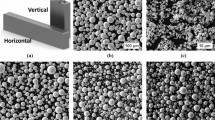Abstract
The fabrication of rhenium metal by powder metallurgy techniques is discussed. The following physical and mechanical properties have been measured and are reported: lattice constants, melting point, electrical resistivity, thermal expansion, spectral emissivity, modulus of elasticity, tensile properties and ductility at room and elevated temperatures, work hardening, recrystallization, grain growth, and oxidation resistance.
Similar content being viewed by others
References
C. Agte, H. Alterthum, K. Becker, G. Heyne, and K. Moers: Physical and Chemical Properties of Rhenium. Ztsch. Anorg. Allgem. Chemie (1931) 196, pp. 129–159.
W. Stenzel and J. Weertz: Precision Determination of Lattice Constants of Non-Cubic Substances. Ztsch. Kristallographie (1933) 84, pp. 20–44.
V. Goldschmidt: The Crystal Structure, Lattice Constants, and Density of Rhenium. Ztsch. filr Physik. Chemie (1929) 2, abstract B, pp. 244–252.
K. Moeller: The Lattice Constants of Rhenium. Naturwissinschaften (1931) 19, p. 575.
F. Jaeger and E. Rosenbohm: Exact Measurements of the Specific Heats of Metals at Higher Temperatures: XII. Specific Heat of Metallic Rhenium. Proceedings Academy of Science, Amsterdam (1933) 36, pp. 786–788.
K. Becker and K. Moers: On the Melting Point of the System Tungsten-Rhenium. Metallwirtschaft (1930) 9, p. 1063.
E. Wood: Physical Review (1947) 72, p. 437.
W. Meissner and B. Voigt: Measurements with the Aid of Volatile Helium: XI. Resistance of Rhine Metal at Low Temperatures. Annalen der Physik (1930) 7, p. 916.
C. Smithells: Tungsten. (1952) pp. 197, 161. London. Chapman and Hall.
R. Levi and G. Espersen: Preparation of Rhenium Emitters and Measurements of Their Thermionic Properties. Physical Review (1950) 78, pp. 231–234.
W. Koster: Poisson’s Ratio in the Periodic System. Trans. Electrochemical Society (1943) 49, p. 233.
Metals Handbook. (1948) pp. 21, 1051, 1131. Cleveland. ASM.
M. H. LaChance, W. L. Bruckart, C. M. Craighead, and R. I. Jaffee: Recrystallization of Wrought Hydrogen-Sintered Molybdenum and its Alloys. Trans. ASM (1953) 45, p. 321.
R. Kiefer and W. Hotop: Pulvermetallurgie and Sinterwerkstoffe. (1943) Berlin. Springer-Verlag.
W. L. Bruckart: Battelle Memorial Institute, un published data supplied.
G. Geil and N. Carwile: Tensile Properties of Copper, Nickel, and Some Copper-Nickel Alloys at Low Temperatures. Circular 520 National Bureau of Standards (1952) pp. 67–96.
O. Winkler: The Frictional Strength of Noble Metals and of Base Metals Having High Melting Points. Ztsch. filr Elektrochemie (1943) 49, pp. 221–228.
Author information
Authors and Affiliations
Additional information
Discussion on this paper, TP 3847E, may be sent, 2 copies, to AIME by Mar. 1, 1955. Manuscript, Apr. 26, 1954. Chicago Meeting, November 1954.
Rights and permissions
About this article
Cite this article
Sims, C.T., Craighead, C.M. & Jaffee, R.I. Physical and Mechanical Properties of Rhenium. JOM 7, 168–179 (1955). https://doi.org/10.1007/BF03377474
Published:
Issue Date:
DOI: https://doi.org/10.1007/BF03377474




